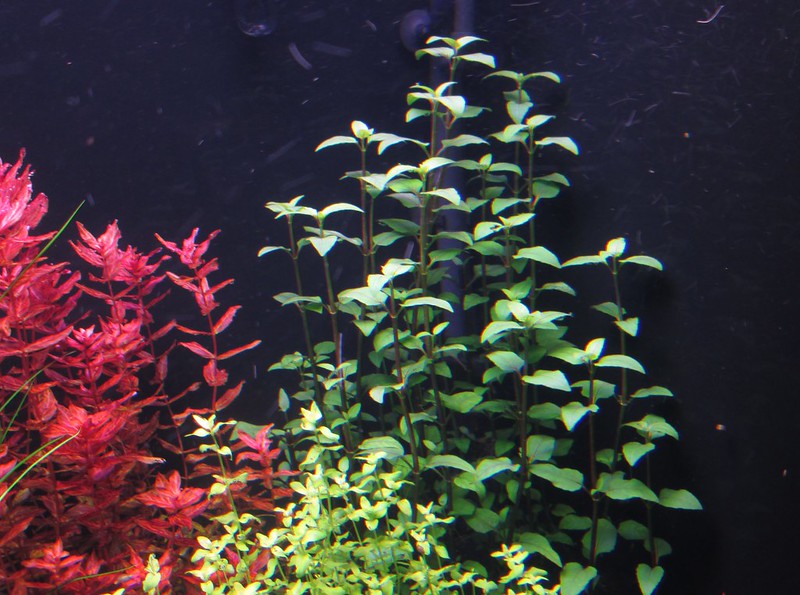So this is a journal for my new 120, which replaces my long running 75 gallon. For anyone who followed the previous tank, this one will be basically the same style with just a bigger footprint.
First planting, about 2 months ago.
![Image]()
Tank
48" x 24" x 24" Marineland 120 gal
CO2
GLA Grow 1 regulator, 10 lb tank.
DIY PVC reactor. Main pipe is 3" x 24"
![Image]()
CO2 cuts on 90 min before the lights, goes off 1 hour before. PH drops 1.1 by lights on, proceeds on down 1.3-1.4 at peak. Livestock are fine at this level, heavy flow and good surface agitation helps.
Filtration
Two canisters: 1 Aquatop CF 500, and 1 Hydor Pro 600
Measured flow combined is about 600 gph.
1 Koralia Nano 425 for added circulation
Both canisters have SunSun intakes with the skimmer
Left corner is the the Aquatop. Using a 1" outflow pipe to reduce velocity (the in-tank flow is crazy!)
![Image]()
Right corner is the Hydor. The CO2 runs inline with this one.
![Image]()
![Image]()
^also you can see my LED night lights, mounted on each end of the main fixture.
Substrate:
Black Diamond blasting sand
Lighting
6 bulb T5HO hydroponic unit
https://www.amazon.com/Agrobrite-Designer-FLP46-6-Tube-Fixture/dp/B002TJQ61W
![Image]()
Bulbs are front to back:
TrueLumen Flora
Agrobrite 6400K
Zoo-med Flora
Plantmax 3000K
ATI Purple
TrueLumen Flora
Fixture is 9" above the tank, PAR at the sub is around 120. Having lots of red bulbs help keep it down, not to mention awesome color rendition. PAR would be a lot higher at this distance with more 6500Ks, for example
Ferts
Macros 3x week
7.5 ppm KNO3
1.3 ppm K2PO4
3 ppm K2SO4 (for 6-7 total K)
Micros 3x week
.015 Fe from csmb
.02 ppm Fe dtpa
** Micros are more now because Im rolling my own instead of using csmb. Will update the amounts once I arrive at the sweet spot.
50%-60% water change every 6-7 days
Livestock
25 Harlequin Rasboras, will soon get this up to maybe 30 or so
6-7 otos
Trio of young German Blue Rams, just coming into their adult colors
10-12 Amano shrimp
Here's the latest rendition. Plant groups are no way shaped for height or footprints. Mainly just tentative placeholders of where things are going to be. Have lots of ideas to try, and open to any suggestions!
![Image]()
Detailed plant pics to follow....
First planting, about 2 months ago.

Tank
48" x 24" x 24" Marineland 120 gal
CO2
GLA Grow 1 regulator, 10 lb tank.
DIY PVC reactor. Main pipe is 3" x 24"

CO2 cuts on 90 min before the lights, goes off 1 hour before. PH drops 1.1 by lights on, proceeds on down 1.3-1.4 at peak. Livestock are fine at this level, heavy flow and good surface agitation helps.
Filtration
Two canisters: 1 Aquatop CF 500, and 1 Hydor Pro 600
Measured flow combined is about 600 gph.
1 Koralia Nano 425 for added circulation
Both canisters have SunSun intakes with the skimmer
Left corner is the the Aquatop. Using a 1" outflow pipe to reduce velocity (the in-tank flow is crazy!)

Right corner is the Hydor. The CO2 runs inline with this one.


^also you can see my LED night lights, mounted on each end of the main fixture.
Substrate:
Black Diamond blasting sand
Lighting
6 bulb T5HO hydroponic unit
https://www.amazon.com/Agrobrite-Designer-FLP46-6-Tube-Fixture/dp/B002TJQ61W

Bulbs are front to back:
TrueLumen Flora
Agrobrite 6400K
Zoo-med Flora
Plantmax 3000K
ATI Purple
TrueLumen Flora
Fixture is 9" above the tank, PAR at the sub is around 120. Having lots of red bulbs help keep it down, not to mention awesome color rendition. PAR would be a lot higher at this distance with more 6500Ks, for example
Ferts
Macros 3x week
7.5 ppm KNO3
1.3 ppm K2PO4
3 ppm K2SO4 (for 6-7 total K)
Micros 3x week
.015 Fe from csmb
.02 ppm Fe dtpa
** Micros are more now because Im rolling my own instead of using csmb. Will update the amounts once I arrive at the sweet spot.
50%-60% water change every 6-7 days
Livestock
25 Harlequin Rasboras, will soon get this up to maybe 30 or so
6-7 otos
Trio of young German Blue Rams, just coming into their adult colors
10-12 Amano shrimp
Here's the latest rendition. Plant groups are no way shaped for height or footprints. Mainly just tentative placeholders of where things are going to be. Have lots of ideas to try, and open to any suggestions!

Detailed plant pics to follow....







